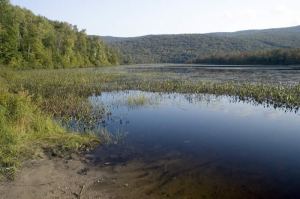Chemical Reactions
Acid rain is nothing new. An increase of burning fossil fuels has led to industrial by-products hanging heavy in the air. This causes decreased production in lakes, release of toxic metals, retained phosphorous, and a change in the carbon source from carbonate to carbon dioxide. [5] Water is naturally acidic (anywhere from a pH of 6-9) [2] but is recently becoming more so.

In an effort to reverse such deleterious effects, a neutralization reaction, known as liming is being used. Calcium carbonate (calcite or limestone,) is added to acidic lakes, reducing the toxic effects of heavy metals, and increasing nutrients, alkalinity and total hardness of water. [1]
According to this article, however, the side effects might not be properly identified. Despite generally favourable results, aquatic organisms are vulnerable during a transition period before metals precipitate to the lake bottom. [4] Liming might be a cost-effective solution [1] for now but the effects of liming have not been fully explored.
Personally, I think that liming is a good starting point. However, we can’t allow this short term solution to impede on the truth that things must change. Liming can show neutralizing effects for 5 to 10 years, but it is not permanent and will have to be reapplied. [7] Lakes are not always restored.
When there is a drastic issue, should we work with it or with what’s causing it? The only sure way to solve acid rain is to reduce emissions but our world depends so heavily on it that it’s just not possible. Are the sources of acid rain too far beyond our control to mitigate? And if so, should liming be our solution?
~
Bibliography
Hey! Cool title by the way, and interesting subject! In my opinion, it’s important to go to the root of a problem instead of slapping a band aid on it. In this cause, as we learned in Gr. 10 science, and as you stated, one of the causes of increased acidity in bodies of water is acid precipitation, mainly caused by US. So how do we address the root of issue of a problem so vast as climate change? I certainly agree when you say that it’s not an easy fix! For now, I suppose, liming will have to be our solution. Hopefully more research will be done, and soon, on more long term solutions to this increased acidity in our aquatic environments.
LikeLike
Yo Erin! I agree with Kate on this subject! I think by avoiding the real issue, we would just be making situations worse. While liming can work for now, if we continued on our path of pollution, conditions could get much worse. It’s possible that what works to decrease acidity in bodies of water now wouldn’t work in the future due to worsening conditions. If we depend so heavily on this one method of water clean-up, we could be screwing ourselves in the long run. These problems remind me of the similar effects caused by pollution which have affected air quality in Edmonton. It seems most environmental difficulties we are facing are due to overall human pollution. I definitely think we need to do a better job of developing new solutions to fix the increased acidity in Canada’s water. We are lucky to have such an abundance of aquatic environments here and fresh water, so we have to work hard to maintain their beauty! – Cami
LikeLike
I think that we can always try to reduce the amount of fossil fuels we use; there’s a new car that Honda is selling in California, it uses hydrogen instead of electricity, or petrol. I’m just trying to say that humans are slowly, but surely trying to reduce the impact we have on the earth. I think liming is going to be a good solution for now, but I hope we eventually get to a point where we don’t need to use liming.
LikeLike
From what you have described liming seems like a good short term solution, but I think it is better to get to the root of the problem. We need to focus on ways to reduce our use of fossil fuels to make any real difference. By using liming we are treating the symptom and not the illness and it is easy to forget about it or say liming is good enough when it really isn’t. Liming is not the solution it just buys more time to find one. I don’t think that we are too far gone to make a difference but we need to start now because eventually we will be.
LikeLike